Importance of Validation
To justify my existence on this planet - and to earn a living in the process - I am an advisor to family run businesses that have the will to "corporatise", and the potential and ambition to internationalise. This work involves four categories of activity:
- Peering far into the future
- Setting a destination, and plotting a course that takes into account the need to navigate through the obstacles
- Structuring the businesses so that they will survive their buffeting along the journey
- Constant validation of all assumptions to ensure that the ship does not veer off course through failure of Management to keep focussed
In the 1960s (courtesy Harry Schultz) I came to understand that there existed a phenomenon called the "Long Economic Wave", and (courtesy a dozen or so other authors) that this wave was driven, initially by the emergence of new technologies; and eventually by the market saturation of these technologies.
In the 1970s I noticed that the world markets for automobiles were starting to boil over as Japanese based manufacturers became more active on the international stage. At that time, the importance of niche marketing started to manifest. In the 1970s I owned and built modest manufacturing businesses in the home furnishing industry that were "niche" players in their target markets.
In the 1980s and 1990s, I started doing what I now do for a living, focussing my attention on the technologies that might become drivers of the next up-leg of the Long Wave. It soon became apparent that Information and Communications Technologies were not the harbingers of a new up-wave, but - to the contrary - they were the harbingers of a "wash-out" of the down-wave. These technology sets facilitated a prolongation of the production of old technology products by allowing them to be produced more cost effectively, and in locations remote from their markets (such as China)
Since the late 1990s I have switched my attention from Technology to "Comfort Food" and "Fast/Convenience Food", and the sensibility of that decision can be validated by the following five year charts (Courtesy Clearstation Charts). The first one compares the performance of the S&P 500 with that of the share price movements of Krispy Kreme Donuts and Cheesecake Factory (who are not my clients):
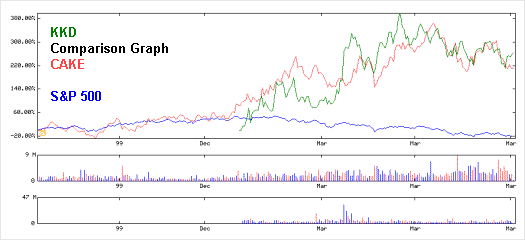
The second one compares the performance of the S&P 500 with Yum Brands (KFC, Pizza Hut and Taco Bell) and IHOP (who are also not my clients)
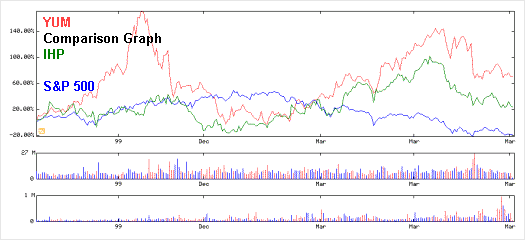
Over the years I have focussed on the fact that the most important discipline that is lacking throughout the business and financial world (and probably also the world of politics) is that of "validation". Grand schemes are hatched, detailed plans are made, large amounts of resources (financial and managerial) are committed, and the "go button" is pressed. Those organisations that realise their goals tend to be highly disciplined in their propensity to validate their assumptions along the way, and those that lack this discipline, typically fail in their endeavours. Very few ever come to understand (until it is too late) that the economy does not grow in a straight line. Most "spreadsheets" and Business Plans that I see are predicated on the base assumption that growth will continue into the foreseeable future.
Of course, such an approach would be quite sensible - subject to one provision: The base assumptions need to be validated relative to our current position in the various Business Cycles. Of interest, the largest capacity is typically installed right at the point where the markets reach saturation point.
As an aside, it came to my attention in the 1990s that the Venture Capital Industry in the USA was populated predominantly by graduates of Harvard Business School, and it was the Venture Capital Industry that facilitated the Nasdaq bubble. You have to be amongst the brightest and the best to get into Harvard Business School, and you also have to be an "all rounder" (someone who plays sport, participates in community activities, and demonstrates leadership capabilities). So, with my propensity to want to always validate base assumptions I can't help wondering about the base assumptions on which the Harvard MBA program has been built.
But all of this is background to the main purpose of this article - which is to validate my own views and conclusions regarding the direction of the gold/silver markets, the industrial markets, and the bond yields. I am less interested in where I have been right than I am in determining where I might be going wrong. There is no place for ego in a productive life. Ego will enable you to "force" your way to the top, but then it will become your biggest enemy when you come to believe that you are invincible (which is why we need to be very circumspect regarding the decisions of politicians who are typically driven by their egos). This latter statement is not intended to be just another little homily. It goes to the heart of the problems we ordinary folk are facing in the world today.
Up to last week, my views on the subjects which I would like to validate here (or not) were as follows:
- Gold/Silver: Primary Bull market, subject to probable consolidation below $400/oz and $5/oz respectively, until such time as a clear direction in the US economy emerges - which clarity would probably be capable of obfuscation by the politicians until after the US Presidential elections.
- Industrials: Primary Bear Market. Possibility of a "market crash" if last October's lows are penetrated on the downside. Probability that the politicians would throw everything but the kitchen sink at the markets in an attempt to prevent such a crash, and in an attempt to create a sort of "Indian Summer" leading up to the elections.
- Bond Yields: Reaching for a bottom. USA will probably experience stagflation, whilst the rest of the world experiences deflation. Interest rates will rise in the USA and fall elsewhere.
To cut to the chase, I am coming to the conclusion that I may have been wrong regarding 3 above. This is worrying me, because it has some serious implications. However, lets devote some mind space to quickly validate 1 and 2 above.
Last week I focussed on the possibility that the $XAU (and therefore by implication the gold and silver prices) might be facing a period of consolidation. I drew your attention to a few Relative Strength charts, two of which have subsequently "validated" my views (which is no reason to relax the vigilance as the markets are very volatile at present).
First: The Relative Strength chart of Silver Standard Resources has now broken down
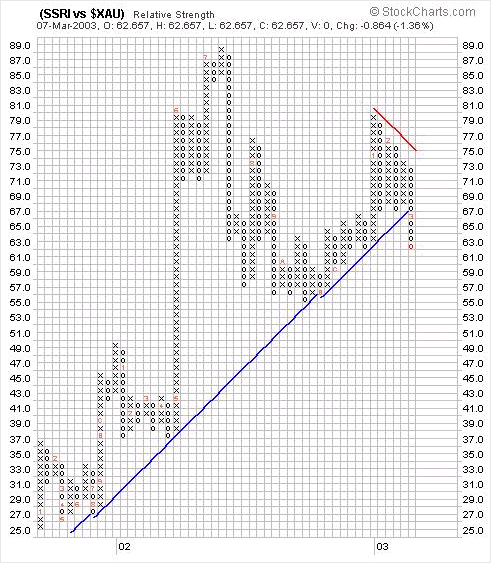
Second: The Relative Strength Chart of NEM is strengthening
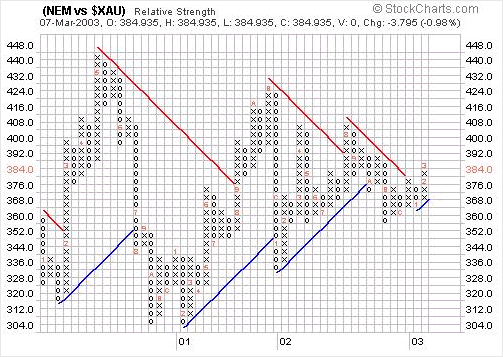
These two occurrences "validate" the conclusion that the $XAU (and gold and silver) may be facing a period of consolidation, because during a sector consolidation the previous over-performers tend to over-perform on the downside, and vice versa.
Does this mean that "therefore" we should sell our gold and silver related investments?" No it does not, because the Primary Bull Trend remains intact. SSRI is a company that controls around 600 million ounces of silver (not yet in production), whilst NEM is the largest gold mining house in the world, and its mines produce around 7.5 million ounces of gold p.a. Both of these are SOLID investments and time is the enemy of neither of them (SSRI has a few million cash in the bank).
The "key" to whether or not you should hold on to your own particular gold/silver investments is "mine life expectancy".
As an aside, most technical analysts will probably be looking at chart formations like the following, and will be concluding that the $XAU is likely to break up from the falling wedge, and they may be right (following a false breakdown). But it does not follow that "therefore, the Primary Bull Market is about to resume in earnest". A break up would be quite consistent with consolidation within the foreseeable future. (Chart courtesy DecisionPoint.com)

Next, let's look at the DJIA and the S&P 500
The first chart is a five year Relative Strength chart which is deserving of some comment.

Note how right at the peak of the market, the overall market (S&P 500) was outperforming the Dow, which comprises 30 "fuddy duddy" blue chip stocks. Note also that as the markets entered their Primary Bear Trend, there was a flight to safety, and the blue chips have since been outperforming the market as a whole. What this tells me is that Professional Investors are still in denial. They probably have not yet accepted that we are in fact in a "Primary" bear market (or they could be right. There is always that possibility)
Nevertheless, when we turn up the microscope a couple of notches, we see that the S&P 500 and the DJIA have been travelling in lockstep over the past nine months:

The institutions are no longer focussing disproportionately on the "safety" of the blue chips, and so any structural change in the market will either come from an upward reversal of the S&P (to catch up to the Dow), or a "crash" in the Dow, to catch up to the S&P.
So lets look at the S&P and lets pay particular attention to volume. For some unfathomable reason, many technical analysts seem to forget about the importance of volume - which typically precedes price (Charts courtesy of StockCharts.com):

The prognosis here is not good. Note how the On Balance Volume chart has already broken below its October 2002 low. This is a bad omen because it does not validate my base assumption regarding the possibility of an Indian Summer.
But there is an anomaly in that the weekly chart does not show the same picture:
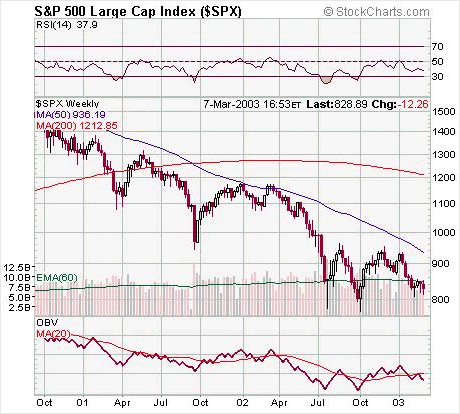
Note how its OBV is showing strength. It is showing a much stronger OBV picture in October relative to July 2002 and, more importantly the OBV is higher now than it was in October. How can this be?
It seems to me there could be two reasons. Either:
- There is something wrong with the way StockCharts calculates its weekly OBV, or
- There is "hanky panky" in the market place and prices on Fridays are being "ramped" to give the impression that things are better than they really are.
Of interest is that the weekly OBV is giving a "sell" signal whereas the daily OBV is showing some signs of reaching for a bottom.
Let's look at the Dow Jones:
Its daily OBV is actually showing some mild strength

Note how its low was higher than the October low, and note how there has recently been a series of rising bottoms even though "prices" have been falling. This is technically known as a "non confirmation" - which could be pointing to a short term change in trend direction. Well, let's use the word "strength" advisedly here. The strength is really more reminiscent of a rush of adrenalin in an exhausted athlete than a second wind. Nevertheless, objectively it is looking like a possible bottom even though the MACD has turned down.
Of interest, the weekly OBV is also showing a sell signal, but is also much stronger than the daily OBV would seem to imply:

On balance, however, I'm not comfortable. Something is not quite right and my "Indian Summer" scenario - whilst still not invalidated, also cannot yet be validated to a high degree of confidence.
It will be invalidated if the October lows are tested and FAIL, and will be finally validated if the October lows are tested and HOLD. But one thing seem certain: This market is not going to give up without a fight, and the Indian Summer scenario is still a possibility based on logic. Certainly, the markets will have the final say and I will continue to watch and validate.
Which brings us to the area of my greatest concern, and that is the bond yields. I don't enjoy taking a position that is contrary to what the markets appear to be saying, and the "voices in my head" have been telling me that something is off centre regarding the bond yields.(ie My contrary view may turn out to be wrong)
An analysis of the Point and Figure charts led to some interesting conclusions:
- When the 30-year yields broke down through the 5.4% support, the downside count was 4.7%, which target was reached.
- Since this level was reached, yields have been consolidating and, if they break UP could rise to 5.6%. Alternatively, if they break DOWN, they could fall to around 4%.
What, if anything, are the charts telling us?
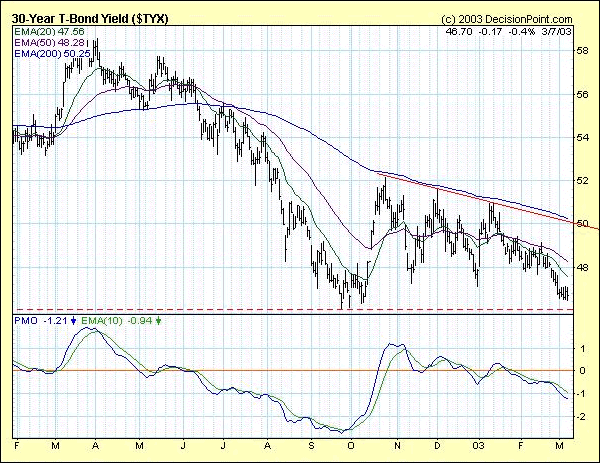
On the one hand, it could be argued that the yields have just broken "down" from a descending triangle - which is bearish. On the other hand, there could be a double bottom bounce and the 4.6% level could hold. One factor that seems important to me is that the PMO is at a level that is MUCH HIGHER than the October low.
So lets ratchet up a bit:
Other oscillators (rate of change and the MACD histogram) appear to be pointing to a possible bottom. Note how the most recent "bounce" in the rate of change chart is occurring at a level that is higher than the November bottom even though the yield itself is lower than the November low. This represents another non-confirmation.

Now let's look at the weekly chart. Note how the MACD histogram is showing a sell signal, but the rate of change oscillator is showing some relative strength.
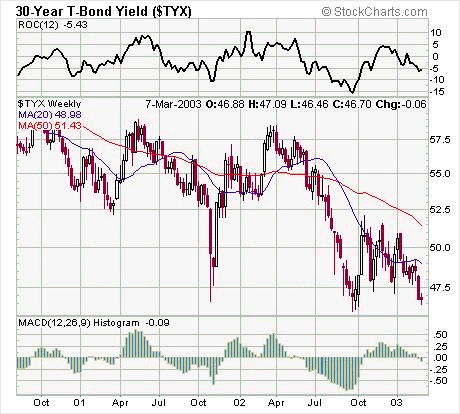
Objectively, the jury is still out. For a trend reversal to be even possible, yields will have to rise above 5%, but there is clearly a battle raging. Note how the 20 week MA has turned down after trying to change direction (its what gave rise to the MACD sell signal)
OK let's play Devil's Advocate
Can I imagine a scenario where the USA does NOT experience stagflation (which is my current view)? The answer is "of course I can". Here it is:
- China's currency is pegged to the US Dollar. A collapsing dollar will more likely lead to a collapse of living standards in China than inflation within the USA. As China is the USA's biggest trading partner, US citizens are being shielded from inflation by Chinese citizens' propensity to suffer ignominy at the hands of the gwaelo and at the behest of its own government.
- Manning of the printing presses by the Fed is like pushing on a string. If lenders are nervous to lend and/or borrowers are nervous to borrow, then the velocity of money swill slow. If demand slows, upward pressure on prices abates.
The problem that I have with this scenario is that deflation within the USA will have a very high probability of culminating in a Depression with a capital "D" because if demand slows, the economy may tank - which is why the authorities are doing there level best to reflate the economy.
Conclusions
In this article I have attempted to validate my current view "set", but I was only partially successful in reaching a definitive conclusion:
Gold/Silver: Continuing consolidation more likely than not. Key Relative Strength charts pointing to a pause in the Primary Uptrend.
Industrials: Indian Summer still possible within the context of a Primary Bear Market. However, there are conflicting signals and signs of external "interference". Whilst the interference is consistent with the rationale that an Indian Summer is desirable, the charts are weak. The only validation of my view is the non confirmation of the OBV chart and the Price chart. However, any validation is better than an invalidation. So I will hold my view for the time being.
Yields: I continue to be extremely nervous that I may turn out to be wrong here. If that happens - ie if the yields break below 4.6% - then it highly likely that my entire view "set" will need to be reassessed. A breakdown in the yields will be a strong signal that deflation within the USA may be a higher possibility than inflation - in which case we might see a collapse in the industrial markets.
Overall Conclusions
I am not yet ready to make the call to change my current view set. Right now the charts show evidence of a titanic battle raging between the reflationists and the deflationists. If the reflationists win (which is what I currently expect) then we will have an Indian Summer followed by a resumption of the Primary Bear Market in about a year's time. At that point, the gold price is likely to "finally" break the $400 barrier and start to scream upwards whilst the S&P 500 trends sideways with mini bull and bear markets for up to a decade.
On the other hand, if the yields break decisively below 4.6%, then this will be a leading indicator that the authorities may have lost the game; and that the overall market forces are just too overwhelming to manage. In this case, the October lows on the industrial equities markets are unlikely to hold for much longer and these markets could tank before the Presidential elections as deflation starts to set in. Under these circumstances, expect a low of 500 on the S&P and possibly a worst case scenario of 250 before the end of the decade. Under these circumstances, gold will have no need to break above $400 because it will hold its value relative to falling prices; but gold shares will likely pull back significantly - because several are already factoring in a gold price of $540/oz.
Recommendation
There are technologies waiting in the wings that can be used to "drive" the next upleg of the Long Wave. A ratification of the Kyoto protocols will open the floodgates to the commercialisation of these technologies - the most important of which is the "Fuel Cell". A full blown commercialisation of Fuel Cell technology (and its accoutrement of supporting technologies) will, in my view, be sufficient to turn the tide in the war against deflation.
















